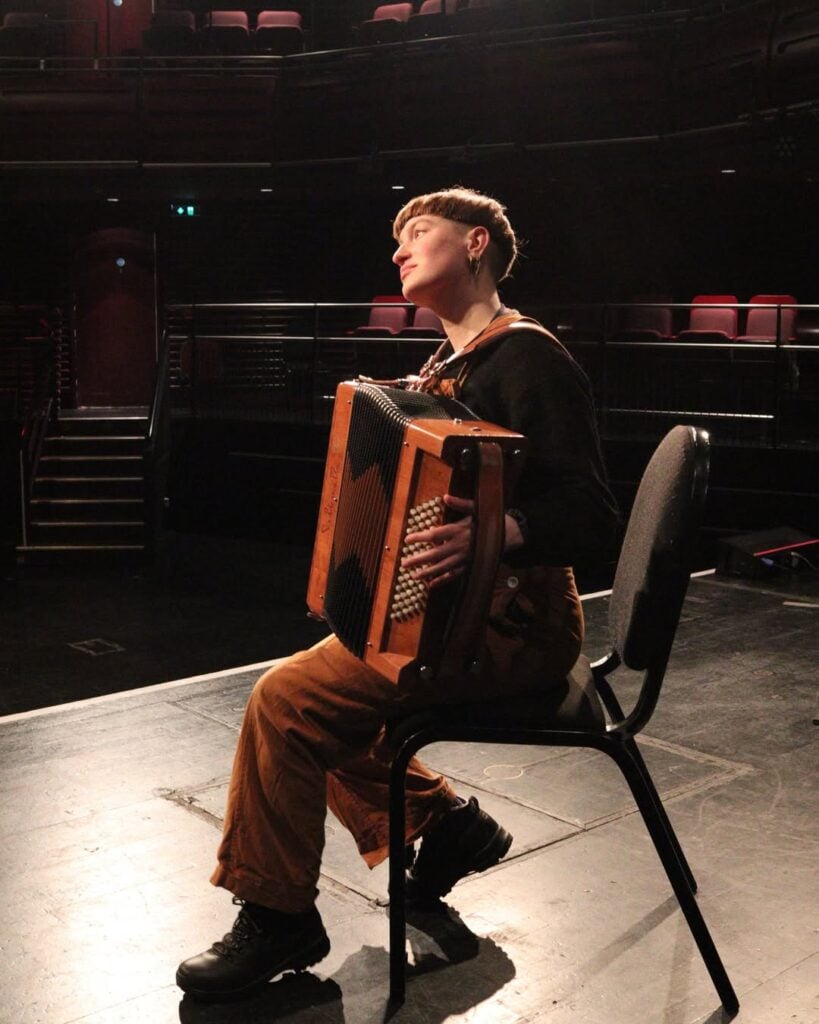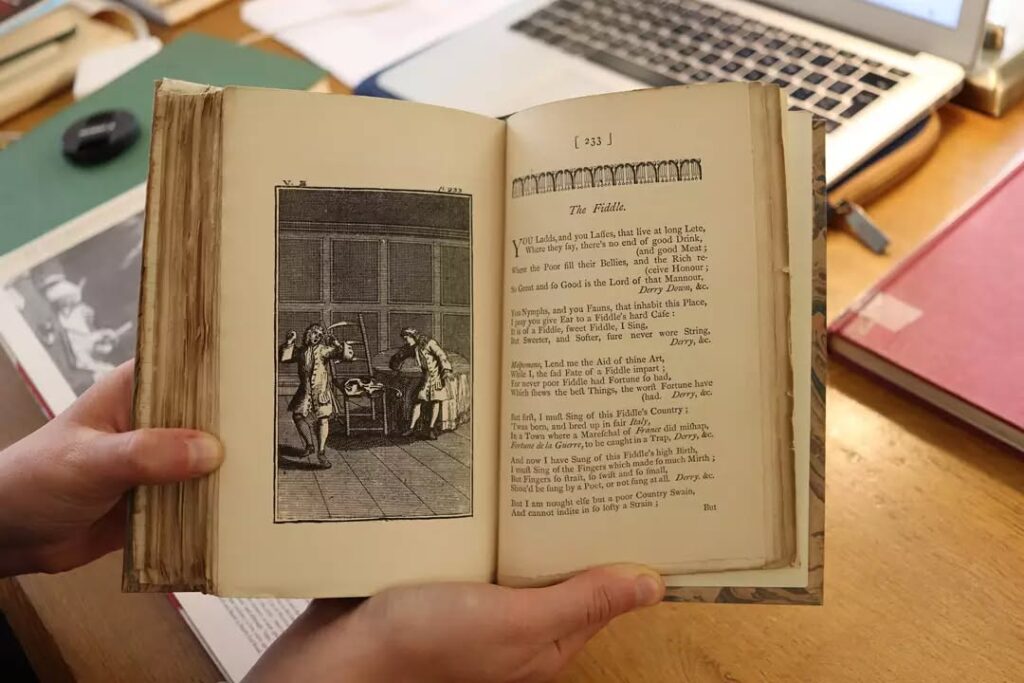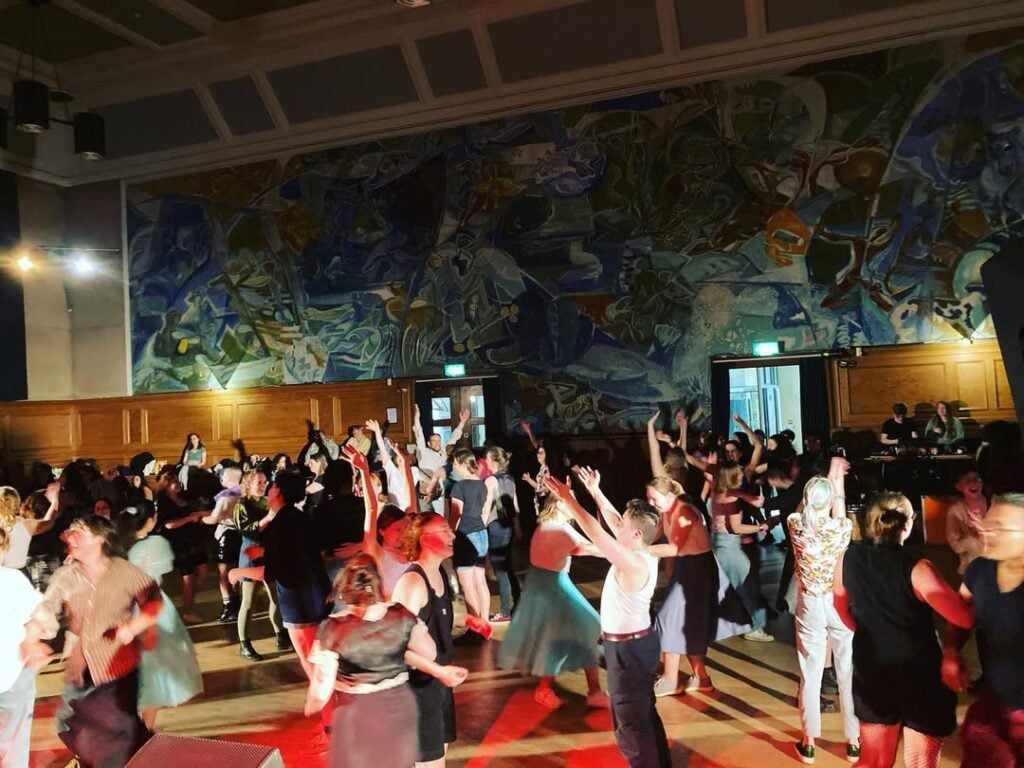Queer Folk: we’re all making the music richer
Q&A
Queer Folk platforms LGBTQIA+ history and narratives buried in the folk music archives, while also amplifying queer artists today. Founders Sophie Crawford and George Sansome close this year’s Future Folk series with a rich evening of traditional song – some familiar, some not, but all filled with queer joy.
How did Queer Folk come to be?
George: We first got in touch when I was launching my debut solo album via a livestream in 2020. I’d come across Sophie’s singing on one of my favourite folk song database websites and asked her if she’d be up for sending me a video of a song as a “support slot” for the album launch. I thought she may be queer but was too shy to talk about it!
Eventually we got back in touch via a Facebook group for LGBTQIA+ folk musicians when we’d spotted each other talking about wanting to do some sort of project highlighting LGBTQIA+ stories and people in traditional music. We spent a few months having zoom calls and eventually made it into the same room at Cecil Sharp House for a residency there. We got stuck into the archives at the Vaughan Williams Memorial Library and it’s just sort of snowballed since then!
‘...not seeing people visibly and vocally representing LGBTQIA+ people made it feel like being queer and into folk music were two incompatible things.’
Why is queer representation important in the contemporary folk scene?
Sophie: Neither George or I had Queer representation within the folk scene growing up and from my perspective it would have made a huge difference in terms of my journey in coming out. Folk music was the centre of all things for me and not seeing people visibly and vocally representing LGBTQIA+ people made it feel like being queer and into folk music were two incompatible things. If every song and tune that you play seems to be representing a heteronormative past and if no one around you is talking about LGBTQIA+ people and lives then it can feel like we don’t exist.
It’s very important that we highlight LGBTQIA+ historical presence in traditional music so that we counter the long efforts that have been made to erase LGBTQIA+ history and lives as well as work against moves by far right groups to co-opt folk music and culture into fascist ideologies. By showing that the contemporary folk scene contains queer history and queer musicians we’re working to make the scene accessible and thrive. It’s very important everyone feels able to access this music as a foregrounding principle of folk music is that it belongs to everyone.
Equally by highlighting LGBTQIA+ presence in the folk scene we’re acknowledging that this is part of an effort towards collective liberation, therefore we’re just part of the wider process of acknowledging the history and continued contribution of BIPOC, different faith groups, travellers and many others within folk and traditional music. We’re all making the music richer!

Tell us about the Queer Folk network and what you do to bring LGBTQ+ musicians together.
Sophie: We have a few different strands to our work – it’s a bit of a balancing act at times! We’re both musicians and play together as well as solo, and in other combinations, so performing is a part of what we do. We have the research side of things where we dig into archives, look for old songs and stories – the sort of activities we’ve done on our residencies with the EFDSS and Britten Pears Arts. We’ve also led a few workshops putting LGBTQIA+ musicians together, having some great conversations, and sharing our research to prompt new music-making.
Back in April we led our first Queer Folk Weekend at Halsway Manor (National Centre For Folk Arts) which was an absolute joy. Around 30 LGBTQIA+ people sharing music, learning, making new connections and friendships, and just going deep into queer folk music. We loved it so much that we’re doing another one this year!
And we haven’t talked about dance yet! We regularly host ceilidh dances at Cecil Sharp House in London, and across the country. Our Queer Ceilidh Dance Parties include gender neutral calling and a drag performance in the interval – it’s so much fun to have a room full of people dancing, making friends, and just being themselves!
‘...queerness runs deep in traditional music, and sometimes we just have to shift our mindset to see it.’
Can you tell us your favourite/most illuminating discovery from your research into queerness in the archives of trad music?
George: There’s loads to choose from, but for me I think it’s more of a general feeling. We started out thinking that we’d have to do loads of digging to find obscure references to queer stories, but actually ended up realising that there’s so much hidden in plain sight. So I suppose the discovery is that queerness runs deep in traditional music, and sometimes we just have to shift our mindset to see it. LGBTQIA+ people have always existed – so queerness and trad music are inextricably linked.

How do you express your queerness in your music and performances?
George: As a singer – I can sing traditional songs that have a strong queer narrative. Sometimes this might be really obvious from the outside, but other times I may change the odd word in a song, or even just have a subtle feeling that the narrative, or characters, feel queer. I tend to sing songs that resonate with me, but can’t always put my finger on the exact reason the song has drawn me in.
With instrumental music it’s a little different, as aside from tune titles, the possibilities for expression can be a little more abstract. But this is just as powerful, and can be just a feeling which I have for myself when I’m playing. I do absolutely love playing for our Queer Ceilidhs, when I get to play Nat Brookes’s amazing tunes with her and Beth Gifford, and share a feeling of togetherness with a load of LGBTQIA+ people dancing and having a great time!
‘'You are the tradition bearers! It’s on you to write the new traditions and carry/ re-write the old ones!'’
What can we expect from your upcoming Future Folk performance?
Sophie: We’ll be providing you with songs we found through our archival research at the Vaughan Willams Memorial Library and through a BrittenPears residency. Expect some familiar songs that you never thought of as queer, some songs you’ve never heard that definitely are and some songs that our queer through our framing! We want it to be a source for anyone hunting for LGBTQIA+ folk songs! Songs to learn and sing yourself!
What piece of advice would you give to aspiring LGBTQIA+ folk musicians?
Sophie: Just make music! Write your own songs, start sessions, organise meet ups and all go together to existing sessions and gigs. There’s always strength in numbers so going with another LGBTQ+ person to an existing folk club or session is a great way of getting confidence. But you are the tradition bearers! It’s on you to write the new traditions and carry/ re-write the old ones!

How can people get involved and support your work?
Sophie: We run regular queer ceilidhs that take place at Cecil Sharp House in London as well as in Sheffield. We also create a monthly radio show that features interviews and music by LGBTQIA+ folk artists – it’s a great way of finding new artists.
Each summer we hold a Queer Folk residential course/ get together at the National Centre for Folk Arts where people are encouraged to make music together and form new LGBTQIA+ bands. And we’re releasing an album of queer folk music sourced from our research!
People can get involved by coming along to a ceilidh or to our course, they can listen to the radio show or buy our new album! And they can always find out updates from us on our Instagram.
George Sansome plays solo and is often out on tour with bandmates in Granny’s Attic, as well as in his duo with Matt Quinn.
Sophie Crawford plays solo helps run the Harrison Singaround in London that takes place on the third Saturday of every month downstairs at the Harrison Pub (WC1H 8JF).